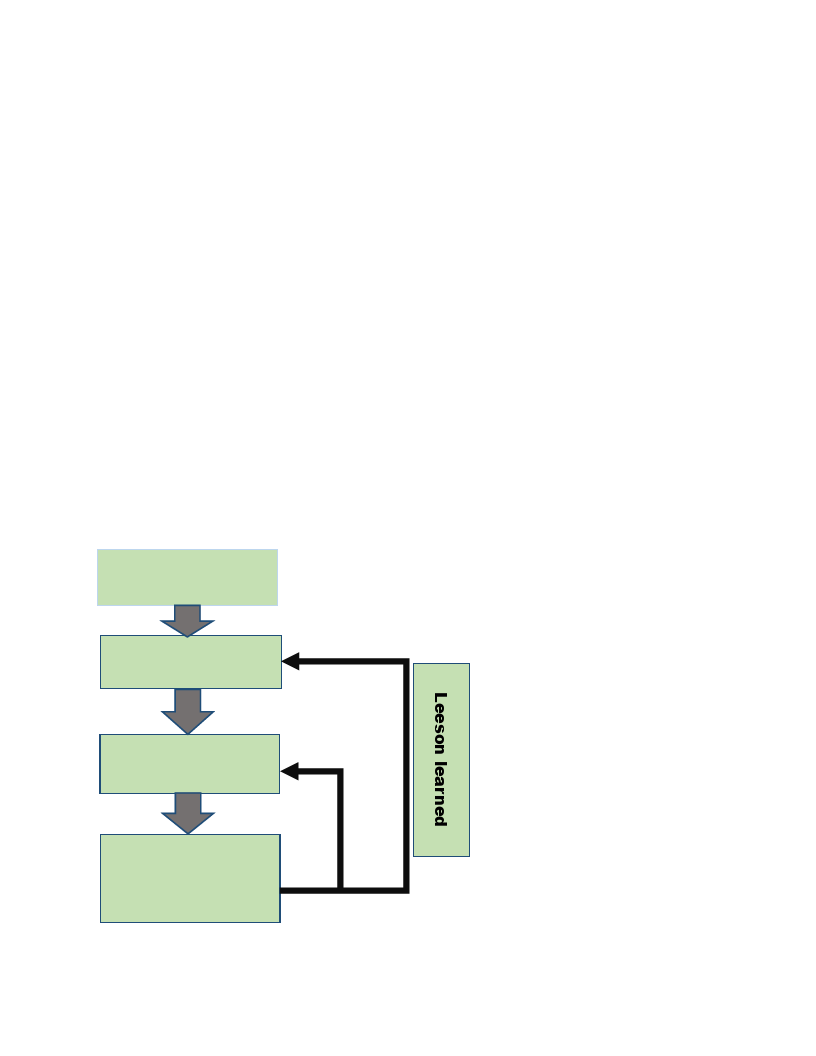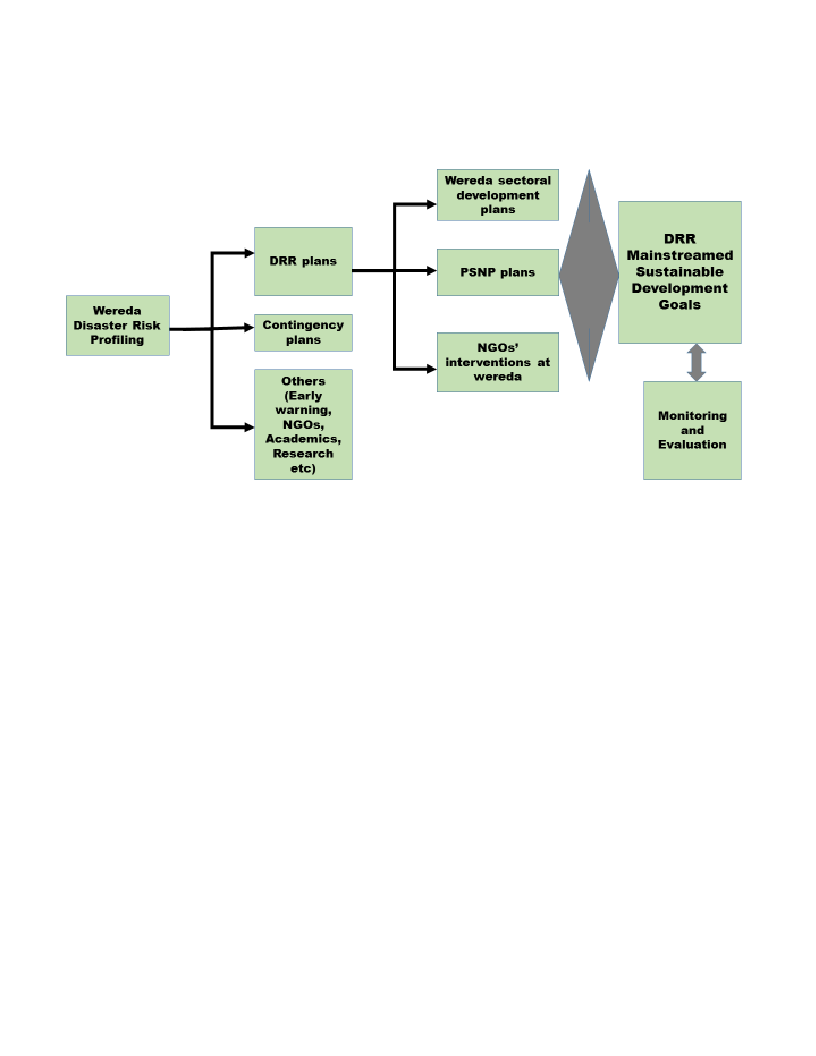
FEDERAL DEMOCRATIC REPUBLIC OF
ETHIOPIA
NATIONAL DISASTER RISK MANAGEMENT
COMMISSION
Mainstreaming Disaster Risk and Climate Change
Mitigation and Adaptation Strategies into
Development Plans
Guideline for users at wereda level
April, 2016
i

CC
DRM
DRR
DRR/CC
GTP
M&E
MEFCC
NDRMC
PSNP
SPIF
UNISDR
WDRP
Abbreviations
Climate change
Disaster Risk Management
Disaster Risk Reduction
Disaster Risk Reduction and Climate Change
Growth and Transformation Plan
Monitoring and Evaluation
Ministry of Environment, Forest and Climate Change
National Disaster Risk Management Commission
Productive Safety-Net Program
Strategic Program and Investment Framework
United Nations International Strategy for Disaster Reduction
Wereda Disaster Risk Profiling
ii

Table of Contents
1. Introduction............................................................................................................................. 1
1.1. Disasters in Ethiopia ............................................................................................................ 1
1.2. DRM Policy and SPIF ......................................................................................................... 2
1.3. Wereda Disaster Risk Profiling and Disaster Risk Mitigation and Adaptation Plans ..... 3
1.4. Objectives of this Guideline ............................................................................................. 4
2. DRR Mainstreaming into Development Programs ................................................................. 5
2.3. Prerequisites for Mainstreaming DRR Strategies into Development Plans ..................... 5
2.1.1 Awareness Raising......................................................................................................... 6
2.1.2. Establishing an Enabling Environment......................................................................... 7
2.1.2.1. Legislation.............................................................................................................. 7
2.1.2.2. Disaster Risk Management Strategy ...................................................................... 8
2.1.2.3. Institutional Arrangements and Capacity for DRM............................................... 9
2.1.2.4. Integration of Disaster Risk Reduction into National and Local Government
Development Planning........................................................................................................ 9
2.1.2.5. Intra-government Horizontal and Vertical Integration ........................................ 10
2.1.2.6. Budget Consideration........................................................................................... 10
2.1.2.7. Project Appraisal.................................................................................................. 10
2.1.3. Measuring Progress: Setting Disaster Risk Reduction Goals and Related Indicators 10
2.1.4. Lessons Learned: ........................................................................................................ 11
2.2. Wereda Level DRR Mainstreaming Processes, Methods and Activities........................... 11
2.2.1. Organize DRR Mainstreaming Workshop.................................................................. 12
2.2.2. DRR mainstreaming methods and activities............................................................... 14
2.2.3. Preparing and Finalizing Mainstreaming Document for the Wereda ......................... 16
2.2.4. Monitoring and Evaluation Mechanism...................................................................... 16
iii

3. Definition of disaster risks and terminologies .......................................................................... 18
3.1. General category of hazards in WDRP .............................................................................. 18
3.2. Terminologies .................................................................................................................... 21
References:.................................................................................................................................... 27
Appendix 1. Disaster Risk and Climate Change Adaptation and Mitigation Strategies .............. 30
Appendix 2. List of Productive Safety Net Program Activities.................................................... 35
iv

1. Introduction
1.1. Disasters in Ethiopia
Ethiopia is exposed to a wide range of hazards associated with the country’s diverse geo-climatic
and socioeconomic conditions. Drought and floods represent major challenges, but a number of
other hazards affect communities and livelihoods. These include: frost and hailstorms, crop pests
and diseases, livestock diseases, human diseases, conflicts and other manmade hazards (like
price shocks/inflation, car accident etc), landslides, earthquakes and urban and forest fires. Major
disaster risks (such as drought, flood, frost, hailstorm, crop diseases and pests and livestock
diseases) mainly affect agricultural production thereby deteriorating the overall economy of the
country and the livelihoods of households (particularly smallholder farmers and vulnerable
groups of the community). This is due to the fact that agriculture is the main economic activity in
Ethiopia and the overall economic growth of the country is highly dependent on the success of
the agricultural sector. The sector represents 42% of the GDP of Ethiopia and about 85% of the
population gains their livelihood directly or indirectly from agricultural production (CSA, 2015).
As a result, it plays an important role in the country’s political, economic and social stability.
However, Ethiopia’s agriculture is mainly subsistence, traditional and rain-fed which is highly
vulnerable to the above mentioned hydro-meteorological and biological hazards. The resilience
capacity of stallholder farmers and the country in general is also low.
Many studies have indicated that disaster risks are increasing globally. Ethiopia is also facing
challenges from frequent occurrence of disasters particularly drought and flood for many
decades. Studies indicated that the magnitude, frequency and effect of drought have increased in
Ethiopia, now encompassing almost all parts of the country. Historically, the widely known
catastrophic event of the 1984 drought killed hundreds of thousands and affected millions of
lives in Ethiopia. Moreover, 14 million people affected by drought in 2003, and in the period
between 2000 and 2007 the number of people affected was never less than 1.5 million (NDRMC,
2014). In 2015/16, about 10.2 million people are being supported with food and non-food items
due to the 2015 drought effect caused by El-nino. The humanitarian requirements document
indicated that 1.4Billion USD is required to address the crisis (HRD, 2016). This has shifted
scarce government fund intended for development purposes towards emergency response which
1

reduced budget availability for large development projects being implemented by the
government. This implies that disasters lower economic growth in two ways: first by causing
damages on lives, livelihoods and physical assets and second by diverting limited resources
allocated for development purposes towards emergency responses.
Much has been done in the last few decades in the way of managing disaster risks. Large scale
programs have been designed for prevention and mitigation, household asset building, and public
works for environmental rehabilitation and generation of livelihoods. Despite these activities and
fast economic growth, Ethiopia is still vulnerable to the impact of disasters which impose serious
impediments to development, destroy years of effort, delay and affect vast investments and
perpetuate poverty. Among others, the vulnerability of the country is aggravated by rapid
population growth, low agricultural productivity, land degradation and climate change.
Ethiopia’s new DRM policy is designed to respond to these challenges in conjunction with the
national GTP strategy.
1.2. DRM Policy and SPIF
Until recently Ethiopia has mainly applied a reactive disaster management approach, which
refers to helping and supporting people after they had been affected by disasters. However, due
to increasing disaster risks and expanding losses as well as lessons learned, the government of
Ethiopia adopted new national DRM policy and strategy in 2013. This has paved the way for
paradigm shift in policies and strategies towards a proactive approach to disaster risk reduction.
This new approach gives focus to preventive actions, while recognizing the continued
importance of well prepared and coordinated emergency support. The policy also emphasized a
shift from previous one-sector and few-hazards (drought and flood) approach to multi-sector and
multi-hazard approach, where all hazards will be given attention and all sectors participate in
DRM activities.
This DRM policy also gave emphasis to mainstreaming DRM into development programmes. It
states that disaster risk management activities shall be implemented as integral to development
plan frameworks, and it shall be ensured that disaster risk management is mainstreamed into
development programmes across all sectors.
2

Along with DRM Policy, the SPIF is also prepared to facilitate and coordinate DRM activities in
Ethiopia. The SPIF provides a strategic framework for the prioritization and planning of
investments that will drive Ethiopia’s Disaster Risk Management system. It is designed to
operationalize the DRM policy by identifying priority investment areas with estimates of the
financing needs to be provided by Government and its development partners. It outlines major
areas of investment that can be more fully fleshed out with development partners moving
forward (DRM-SPIF, 2014).
The SPIF identified 20 programmes which include risk assessment (disaster risk profiling),
disaster risk reduction programmes and integration of climate change with disaster risk
reduction. It also outlined DRM mainstreaming program to ensure that DRM components are
integrated across all sectors and development activities. To address these areas of DRM-SPIF,
Wereda level disaster risk profiling have been done and disaster risk reduction (DRR) strategies
and activities have been developed using the risk profiles for each wereda. These DRR strategies
include climate change mitigation and adaption strategies and activities at wereda level.
Shall we add more?
1.3. Wereda Disaster Risk Profiling and Disaster Risk Mitigation and Adaptation Plans
Among programs and strategies identified in SPIF, Wereda Disaster Risk Profiling (WDRP) has
been given priority due to the fact that risk assessment in each area is the first step towards
mainstreaming and implementing DRM activities at all level. To meet the objectives of new
DRM policy and strategies, NDRMC initiated the task of identifying risk elements (hazard,
vulnerability and capacity) and their underlining causes in each wereda of Ethiopia in the form of
wereda level disaster risk profiling. Therefore, WDRP can be defined as representations of
information regarding a population, place or system’s exposure, sensitivity and resilience to a
given hazards that can be applied to disaster risk management strategies.
Standard scientific procedures have been used to undertake WDRP studies. This study is being
conducted in each wereda of Ethiopia. Cluster and systematic sampling techniques have been
used to select an average of 400 sample households from each wereda for this study. Moreover,
focus group discussions (FGD) were done in all kebeles of the wereda with community
3

representatives. Key Informant Interviews (KIIs) were also made to collect information from
government and non-government institutions operating in each wereda.
Profiles are being developed for all weredas in Ethiopia and so far 300 WDRPs have been
finalized and released. These will help decision makers at all levels to be better informed about
the nature, magnitude and key factors that render people, livelihoods, environment and
infrastructures vulnerable to disasters in specific area. Among others, WDRP provides multi-
hazard and multi-sector information and strategies to decision makers and development partners
so as to mainstream disaster risk management activities to their respective sustainable
development agendas.
Based on the information obtained from WDRP, disaster risk mitigation and adaption plans are
prepared at wereda level. During DRR planning process at wereda level, experts from agriculture
sector (crop, livestock and natural resources), health, water, education, finance and
administration have participated. All disaster risks identified at wereda (and kebele) level are
considered during planning process. Most disasters in Ethiopia are climate related and hence,
DRR1 strategies developed include climate change (CC) mitigation and adaption strategies and
activities. Additional climate change mitigation and adaptation strategies were included from
MEFCC (Ministry of Environment, Forest and Climate Change) guideline prepared to integrate
climate change into development agendas. The final step is to mainstream these DRR strategies
identified for all-hazards and all-sectors into their respective wereda sectoral annual development
plans. (Shall we discuss all cycle: from training, data collection to DRR and mainstreaming?)
1.4. Objectives of this Guideline
To present key concepts in DRR mainstreaming
To discuss general steps followed during DRR mainstreaming into Development plans
To present processes, methods and activities for DRR mainstreaming into wereda sector
annual development plans at wereda level
To outline monitoring and evaluation mechanisms
1 In this guideline, DRR strategies refers to disaster risk mitigation and adaptation plans which include climate
change mitigation and adaptation plans as well as PNSP activities at wereda level. Therefore, DRR strategies,
disaster risk mitigation and adaption plans and DRR/CC strategies are interchangeably used to refer to the same
thing, i.e., disaster risk mitigation and adaption plans which includes climate change mitigation and adaption
strategies.
4

2. DRR Mainstreaming into Development Programs
DRR mainstreaming into development plans refers to incorporating disaster risk mitigation and
adaptation strategies and activities into regular sectoral annual development plans.
Mainstreaming DRR into development plans is important due to two major reasons:
Disasters undermine economic growth and development particularly in developing
countries like Ethiopia.
DRM is not a sector in itself, but a process to protect development progress, reduce losses
and to support growth. It is a cross cutting issue which need to be mainstreamed into all
sectors.
Therefore, under this section, general steps needed for actual mainstreaming activity will be
discussed. Then, processes, methods and activities will be presented for wereda level
mainstreaming of disaster risk mitigation and adaption into sectoral annual development plans.
2.3. Prerequisites for Mainstreaming DRR Strategies into Development Plans
Mainstreaming of DRR generally follow the following steps shown below.
Awareness
creation
Creating Enabling
environment
Measuring
progress
Learning &
experience
sharing
5

2.1.1 Awareness Raising
Awareness raising is the first step towards mainstreaming DRR into development plans. It is
required to secure a solid appreciation and understanding of the relevance of disaster risk
reduction to sustainable development and poverty reduction goals. This awareness is critically
essential to planning and finance ministries as well as federal, regional, zonal and wereda sector
offices, local communities, NGOs and CBOs. Because, DRR is the responsibility of all
government sectors, communities and other stakeholders.
According to Charlotte 2009, awareness raising must be tackled, first and foremost, via the
development of a solid, rigorous body of evidence on:
Hazard mapping and physical exposure
Disaster losses
The socio-economic impact of disasters at national and community level and their
relevance to the sustainable development agenda
The scope for enhanced resilience
In view of this, as indicated in previous sections, NDRMC of Ethiopia initiated the task of
identifying risk elements (hazard, vulnerability and capacity) and their underlining causes in
each community through Wereda Disaster Risk Profiling (WDRP). All disaster risks and socio-
economic information are collected to ensure usability of information by all sectors and
stakeholders. After analysis and compilation of information, the profiles were handed over to
their respective regions, zones and weredas. Awareness creation is made on the results of disaster
risk profiles for all sectors at wereda level. Moreover, the same information is released for all
weredas on website for wide users (check www.profile.dppc.gov.et). Awareness creation is not a
one-time and one-institution/sector job. It needs further work from all stakeholders to raise
awareness on DRM starting from higher officials at Federal Government level to wereda level
decision makers. In addition to NDRMC, DRM offices at region, zone and wereda as well as
DRM units in lead institutions are also expected to create awareness on DRM in their respective
areas.
6

Using information in WDRP, disaster risk mitigation and adaptation strategies were developed
for all sectors at wereda level with regard to major disaster risks in the wereda. These DRR plans
were also given to their respective weredas so that sectors can use for DRR activities.
2.1.2. Establishing an Enabling Environment
2.1.2.1. Legislation
Sufficient, appropriate legislative arrangements for disaster risk management, including the
mainstreaming of disaster risk reduction into development, form a key component of an enabling
environment (Britton, 2006; Pelling and Holloway, 2006). As stated by Britton 2006, without a
comprehensive and binding legal directive that obliges actors and agencies to take action, the
natural inertia of bureaucracies mean that non-specified essential tasks are unlikely to be
undertaken, initiatives are unlikely to be pursued, and the status quo will be maintained.
Therefore, legislation provides the framework around which DRR strategies can be
mainstreamed into sectoral development plans.
The legal framework of NDRMC was developed in December 2015 and it acknowledges the
necessity of providing appropriate and timely response to disasters before, during and after the
disaster period at all levels through establishing a coordinated, accountable and decentralized
system in scalable manner. It also states the importance of backing DRM implementation by all
sectors with legal framework. Among others, the legal framework has given NDRMC the
following major powers and duties:
1. Develop and implement comprehensive DRR and Contingency plans at all levels on the
bases of disaster risk profiles.
2. Ensure that disaster risk management is mainstreamed into Government development
policies, strategies, development plans and programs, and in the plans of the private
sector as well as in the school curricula.
3. Ensure and follow-up the inclusion of DRM in the plans of the executive organs which
are identified as lead sectors in DRM Policy and Strategy Document which include:
Ministry of Agriculture and Natural Resources
Ministry of Livestock and Fishery
7

Ministry of Environment and Forestry
Ministry of Health
Ministry of Water, Irrigation and Energy
Ministry of Federal Affairs
Ministry of Transport
Ministry of Mines
Ministry of National Defense
Ministry of Urban Development, Housing and Construction
Ministry of Education
Lead Institutions at Region, zone, wereda, Addis Ababa and Dire Dawa City
Administration
2.1.2.2. Disaster Risk Management Strategy
A comprehensive disaster risk management strategy, actively involving stakeholders at all levels
of government as well as the private sector, local communities and civil society, is required to
implement the legislative framework and to provide coordination and monitoring mechanisms
and arrangements. Individual disaster risk reduction actions and programs need to be located
within this strategy, rather than treated as discrete, individual measures. Moreover, the strategy
needs to indicate specific entry points and mechanisms for mainstreaming disaster risk reduction
concerns both into the broader development agenda and into the design and implementation of
individual development initiatives (Charlotte, 2009).
As indicated in the previous sections of this document, Ethiopia developed new DRM policy and
strategy in 2013. Along with the policy, Strategic Program and Investment Framework (SPIF)
was also developed. These documents brought about a paradigm shift in direction and led to
doing business differently by moving away from a system that mainly focused on drought and
supply of life saving relief emergency assistance during disaster to a comprehensive disaster risk
management approach, which, unlike in the past, is being implemented with the aim of reducing
disaster risks and potential consequences of disasters by providing appropriate and timely
responses to disasters before, during, and after the disaster period at all levels through
8

establishing a coordinated, accountable, and decentralized system. The documents clearly
indicate priority intervention areas of DRM in Ethiopia.
2.1.2.3. Institutional Arrangements and Capacity for DRM
Disaster risk reduction is a crosscutting issue that needs to be owned by all government agencies
rather than by a single department. However, an overarching national agency is required to
provide leadership, determine broad disaster risk management policies and strategies, advocate
for the inclusion of disaster risk reduction concerns in broader development policies, strategies
and individual initiatives, actively engage a wide range of government agencies in their
implementation, define responsibilities at different levels of government, coordinate this multi-
sector, multi-tiered engagement and monitor and evaluate progress (Charlotte, 2009). With
regard to this, NDRMC will lead, coordinate, implement and monitor disaster risk management
activities in the country. Lead sector institutions will be assigned for every hazard at Federal,
Regional, Zonal, Wereda as well as at Addis Ababa and Dire Dawa City Administrations. A
dedicated structure is expected in those lead institutions to perform DRM tasks. It is also
indicated in SPIF that NDRMC will give capacity building on DRM to all sectors in
collaboration with partners. Generally, institutional arrangements and capacity building still need
much work in the Ethiopia.
2.1.2.4. Integration of Disaster Risk Reduction into National and Local Government
Development Planning
DRR need to be mainstreamed into Federal, Regional, Zonal and Wereda development plans. At
Federal (national) level, it is important to integrate with the second Growth and Transformation
Plan of Ethiopia. Moreover, lead sectors at Federal, Regional, Zonal and Wereda level need to
integrate DRR into their annual development plans. This guideline specifically focus on DRR
mainstreaming into Wereda sectoral annual development plans (detailed mainstreaming process
is presented in the following sections).
9

2.1.2.5. Intra-government Horizontal and Vertical Integration
Horizontal and vertical integration of government and sectors at different levels is also
important. For instance, mitigation of disasters like drought and flooding require horizontal
collaboration between sectors and regional governments. Drought incidence affect most sectors
like agriculture, health, education, water and others hence integration of these sectors is
important. Flooding from highland areas of Amhara Region to Afar Region and highland areas
of Oromia to Somali region also require collaboration between these regions to mitigate the
hazard.
2.1.2.6. Budget Consideration
Mainstreaming of DRR strategies into sectoral development plans require resources. It is mainly
dependent on the annual budget the government allocates for each sector at wereda level. This
budget is usually scarce which results in prioritizing activities at wereda sector level. Due to lack
of awareness and budget limitation, DRR strategies may be ignored during budget allocation to
sector development strategies and activities. Therefore, it is important to ensure that enough
budget is allocated for DRR activities at wereda level. Moreover, since climate change
mitigation and adaptation plans and PNSP plans are incorporated in DRR plans, it is possible to
use funds from climate change and PSNP areas.
2.1.2.7. Project Appraisal
Consideration of disaster risk concerns as part of the project appraisal process is an essential step
in ensuring that development gains from individual projects are sustainable. Like gender-
mainstreaming, disaster risk concerns should also be considered in all components of project
appraisal analysis – financial, economic, environmental, social, institutional and technical –
reflecting the fact that vulnerability to natural hazards is complex and multi-faceted and so needs
to be viewed from all angles.
2.1.3. Measuring Progress: Setting Disaster Risk Reduction Goals and Related Indicators
10

Setting disaster risk reduction goals and related indicators is important for monitoring and
evaluation activities. Disaster risk mitigation strategies and activities mainstreamed into each
sectoral annual development plan will be used as indicator to monitor performance. Goals need
to be set every year with regard to the indicators (or mainstreamed strategies and activities) by
each sector.
2.1.4. Lessons Learned:
Lessons learned during implementation of mainstreamed DRR strategies on the ground will be
used to update mainstreaming process at all stages. Challenges and opportunities during actual
implementation of the strategies will be reviewed and improved every time. This can be done
quarterly or biannually.
2.2. Wereda Level DRR Mainstreaming Processes, Methods and Activities
The following diagram shows the steps followed to come up with DRR mainstreamed
development plan at wereda level sectoral offices. Information in WDRP can be used for various
purposes including DRR and Contingency plans. DRR plans (disaster risk mitigation and
adaptation strategies and activities) will be mainstreamed primarily into wereda sectoral annual
development plans. They can also be used to mainstream DRR activities into PSNP plans (valid
only for PSNP weredas). Moreover, DRR plans help NGOs operating at wereda level to identify
gaps and make interventions on DRR.
11

Wereda sectoral development plans, PSNP plans and NGO interventions that consider DRR
components in their activities result in DRR mainstreamed sustainable development plan at
wereda level. This is in line with Sendai Framework (Transforming Our World: The 2030
Agenda for Sustainable Development) which sets poverty eradication as an overarching aim and
recognizes and reaffirms the urgent need to reduce the risk of disasters. There are 25 targets
related to disaster risk reduction in 10 of the 17 sustainable development goals (SDGs), firmly
establishing the role of disaster risk reduction as a core development strategy (UNISDR, 2015).
2.2.1. Organize DRR Mainstreaming Workshop
Major workshop activities
DRR Mainstreaming Workshop will be held in each wereda for 5 days (to be discussed). The
major activities to be accomplished during the workshop are:
Awareness creation on WDRP and validation of results
Preparation of DRR and Contingency plans
12

Mainstreaming DRR strategies and activities into development plans
Previously, validation of WDRP and preparation of DRR plans were done separately. The
importance of doing these three activities together is to a) save money; b) save time; c) ensure
immediate and timely use of WDRP results and DRR plans. Preparations (such as identification
of DRR strategies for all sectors across major hazards and compilation of major WDRP
indicators) will be made at Federal level ahead of workshop time. Moreover, wereda participants
will be notified about the objectives of the workshop and the agenda ahead of time, so that they
would come prepared with necessary documents.
Workshop participants
No.
Workshop participants
1
Wereda sector planners or sector heads (decide)
Crop (agricultural extension) sector
Livestock sector
Natural resource management sector
Health sector
Education sector
Water, mining and energy
Road and transportation
Administration
Finance and planning sector
NGOs
DRM focal person
Total
2
Participants from Federal, Region and Zone
Number
2
2
2
2
2
2
2
2
2
2
1
21
13

Federal participants
4
Regional DRM focal persons
2
Zonal DRM focal personas
1
Note: it is very important to make sure participation of wereda sectoral planners
Documents required: participants from wereda sectoral offices should come with the following
documents.
Development plan of each sector in the wereda
Compiled wereda development plan from Finance and planning office
PSNP plans at wereda level (for PSNP weredas)
2.2.2. DRR mainstreaming methods and activities
1. The following presentations will be made by Federal/Regional participants
Briefing on DRM Policy and SPIF (1 hour)
Wereda Disaster Risk Profiling, Planning and Mainstreaming Processes and current status
(20 minutes)
WDRP and IMS (40 minutes)
Wereda DRR planning process: for new weredas, the DRR and Contingency plans will be
prepared during this time, and it will take 1 day.
Mainstreaming WDRP and DRR plans to Development and PSNP plans: Concepts and
methods of mainstreaming DRR into development and PSNP plans (40 minutes)
Groups will be formed by sectors to do activities in 2, 3, 4 and 5. Sitting arrangement
by sector (crop, livestock, natural resource, health, water, education,
finance/cooperatives/administration, road ...)
14

2. Understanding wereda planning process: participants will present and discuss planning
process of sectoral development plans. In PSNP weredas, participants will also discuss how
PSNP plans are made. Planning challenges and opportunities in relation to DRR
mainstreaming will be identified and discussed. Discussion and presentation will take 1 hour
and 30 minutes.
3. Review DRR plans for each sector: sectoral DRR plans that are prepared using wereda
disaster risk mitigation/adaptation planning guidelines will be reviewed by each sector.
During this exercise, each sector will identify disaster risk mitigation and adaptation
strategies and activities prepared for major hazards in the sector. Brief discussion will be
made on this part (this part will take 2 hours)
4. Review sectoral development plans and PSNP plans: participants will review their respective
annual development plans and also PSNP plans (for PSNP weredas). In this exercise,
participants will identify strategies and activities indicated in annual plans according to their
relation with major hazards affecting the sector. (Review will take 1 hour).
5. Mainstreaming DRR plans into sectoral development plans and wereda PNSP plans: in
conjunction with reviewing sectoral development plans and PSNP plans, participants will
cross check with DRR plans prepared for each sector and identify the following points (2
hours).
Identify DRR strategies and activities that are indicated in sectoral DRR plans and check
whether they are included into sectoral development plans
Identify DRR strategies and activities that are indicated in sectoral DRR plans and check
whether they are included into PSNP plans
Discuss whether those DRR strategies and activities not included in development and
PSNP plans can be mainstreamed into development and PSNP plans
Identify DRR strategies and activities that cannot be mainstreamed into both
development and PSNP plans and suggest possible ways of implementing them (like
through NGOs, CBOs, private sectors, MFIs, etc)
Finalize mainstreaming activity: prioritize and mainstream DRR strategies and activities
6. General challenges and opportunities of mainstreaming DRR plans to Wereda Sectoral
Development and PSNP plans will be discussed with participants (30 minutes).
15

2.2.3. Preparing and Finalizing Mainstreaming Document for the Wereda
After the mainstreaming workshop, the assigned federal and regional participants will collect all
information raised during the workshop and prepare final document. The document will contain
the agreed upon and mainstreamed DRR/CC strategies for all sectors in the wereda. Then, the
document will be approved and signed by sector offices at wereda level (need discussion on this
part).
2.2.4. Monitoring and Evaluation Mechanism
First, it is very important to make sure that DRR/CC strategies are mainstreamed into wereda
development plans. After mainstreaming into development plans, it is required to outline
monitoring and evaluation (M&E) framework. The following points are considered while
developing M&E framework.
1. Set goals and indicators for each sector: Although the evaluation of DRR/CCA strategies
is a highly challenging task, an appropriate M&E framework will help evaluate whether an
action is justified and whether it is bringing about the intended benefits and ultimately
contributing to building resilience. Therefore, it is important to define indicators to measure
the mainstreaming progress and to establish a necessary M&E system. Mainstreamed
DRR/CC strategies and activities will be used as indicators to measure during M&E. The
following formant is suggested:
Table: Monitoring and evaluation for implementation of DRR/CC strategies at wereda
sector offices
Sector
Eg. Crop
Hazard
Drought
Planned DRR &
CC strategy
Reducing effect of
drought on crop
production
Planned
Activities
Supply short
maturing crops
Supply
drought
resistant crop
varieties
Small-scale
irrigation
Measurement
1000 qt of short
maturing crops
1000 qt of
drought tolerant
verities
500
water
harvesting
structures will
be constructed
at household
level
Performance
% performed
% performed
% performed
Remark
16

Livestock
Drought Forage
development
Growing
alfalfa and
other forage
species
Conservation
of grass areas
Enhancing
collection and
saving of crop
residues
Enhancing
good local
grazing land
management
practices
200 farmers
will
grow
different types
of forages
--- ha
------
households
Awareness
creation
Note: impact of the DRR/CC strategies on the livelihood of the community and on the environment
need to be reported on a separate format.
2. When to do M&E: M&E framework needs to be defined as soon as DRR/CC measures have
been selected and incorporated into sectoral development plans. This will follow the regular
reporting of sectoral offices about their performance; which is quarterly report. Quarterly,
implementation of DRR/CC strategies will be evaluated according to sector plans.
3. How to do M&E: this is done in line with setting goals and indicators as shown in the above
table where we define realistic and measurable output and outcome of indicators. Then M&E
can be done by using quarterly report for each sector or by making field visits to check
implementation of the strategies and activities as planned. (need further discussion)
4. Who will do M&E: implementation of DRR/CC strategies and activities is the responsibility
of sectoral offices at wereda level who incorporated the strategies into their respective
development plans. Therefore, sector heads are primarily responsible to check and ensure the
implementation of these strategies. Besides, DRM focal person at wereda level (in each
sector) will monitor and evaluate implementation of DRR/CC strategies and activities and
report to Wereda Finance and planning office as well as Zone, Region and Federal DRM
offices. (Need further discussion).
17

3. Definition of disaster risks and terminologies
The following definition of hazards and terminologies are provided to support users to have
common understanding of DRM concepts as well as WDRP, DRR/CC plans and mainstreaming
activities.
3.1. General category of hazards in WDRP
Biological hazards: crop pests and diseases, human diseases, livestock diseases, weeds (such as
striga, partinium), invasive plant species like prosopis juliflora, wild animals (such as monkeys,
baboons, lion, crocodile, hippopotamus, pigs, antelopes and others)
Hydro-meteorological hazards: Drought, flooding, heavy rain, hailstorm/ice/snow, frost/cold
waves, heat waves (high temperature), wild fires (if caused by dry weather condition) and others
Geological hazards: earthquake, volcano, landslides,
Social hazards: conflict, economic/price shocks and theft, wild fires (if caused by humans)
18

Technological hazards: road accident, dam failures and pollution from factories
Brief definition of hazards in WDRP
Drought: in Wereda Disaster Risk Profiling (WDRP), drought is defined using community
context and it is explained in different ways. In this study, the community expressed drought in
the form of rainfall shortage (moisture stress), erratic rainfall, uneven distribution of rain, late
on-set and early cessation of rain and water shortage (both surface and underground). Therefore,
the word drought is used to generally represent these terminologies across the country and
specific explanation of drought by the community is explained in each wereda study. For
instance, if ‘wereda A’ reported drought as a major disaster risk, then, in the study, detailed
explanation of the situation is given by the community which may be late on-set of rain during
sowing time. This is in line with many literatures which define drought as a deficiency in
precipitation over an extended period, usually a season or more, resulting in a water shortage
causing adverse impacts on vegetation, animals, and/or people. It is a normal, recurrent feature of
climate that occurs in virtually all climate zones, from very wet to very dry (from Western part to
Eastern part of Ethiopia). In WDRP, drought is usually explained by the community as a root
cause for other disaster risks such as biological hazards (crop diseases and pests, human diseases,
livestock diseases, weeds and wild animal attack) and social hazards (such as conflict).
Hailstorm, ice and snow are interchangeably used to reflect a heavy rain which produces hail
that reaches the ground and results in damage on crops, livestock, humans and property.
Landslide is a collapse of a mass of earth or rock from a mountain, cliff or elevated area causing
damage on lives, properties and physical assets (including infrastructure, land and water
sources).
Biological hazards considered in this study include human diseases, crop pests and diseases,
livestock diseases, weeds, invasive plant species and wild animal attack (such as apes, baboons,
19

lion, crocodile, hippopotamus, pigs, antelopes and others) which cause damage on crops,
livestock, human, properties and physical assets (such as land).
Frost (cold waves): it is a deposit of small white ice crystals (or a solid deposition of water
vapor) formed on the ground or other surfaces when the temperature falls below freezing point of
water (or as a result of cold wave).
Heavy rain: it is defined as precipitation falling with intensity in excess of 0.3 inches (0.76 cm)
per hour. But in our context, any rain with high intensity of precipitation which resulted in flash
flooding and damage on crops, animals, humans, properties and infrastructures is considered
high rainfall.
Flood: it is a great flowing or overflowing of water, especially over land not usually submerged.
A given community may be affected by flooding as a result of high rainfall in the locality or due
to high rainfall in some other area (usually upstream area).
Heat waves (high temperature): they refer to several days of higher-than-normal (or abnormal)
temperatures which have severe effects on humans, animals and natural resources.
Road accident: it is a traffic collision, also known as a traffic accident, which occurs when
motor vehicles, cars, automobiles and other transportation means collide whit another vehicles,
pedestrians, animals, roads and other objects resulting loss of life and property damage.
Conflict: it is a disagreement through which the parties involved perceive a threat to their needs,
interests or concerns. In WDRP, this is usually explained in terms of conflict over resources
(such as water, pasture and farm land), ethnic conflict, border conflict and war (particularly for
Tigray weredas bordering Eritrea).
Earthquake: it is a sudden violent shaking of the ground, typically causing great destruction, as
a result of movements within the earth's crust or volcanic action.
20

Economic/price shock: although this is an unexpected or unpredictable event that affects an
economy (household economy), either positively or negatively, in this study we are referring the
negative effect from the community point of view. Specially, in crop producing areas, the
community explain price shock (also inflation) as high price of consumption goods (industrial
goods) and agricultural inputs (fertilizer, improved seeds and pesticides) that farmers purchase
and low price of agricultural produce (crops, animals and animal products) that farmers sell. In
pastoral and agro pastoral areas, price shock is explained as low price for animal and animal
products and high market price of all other commodities they buy from market (including crops).
3.2. Terminologies
(Note: the following terminologies are adopted from different sources mainly from
UNISDR terminology on disaster risk reduction of 2009 and DRM policy of Ethiopia)
Adaptation: is an adjustment in natural or human systems in response to actual or expected
climatic stimuli or their effects, which moderates harm or exploits beneficial opportunities.
Biological hazard: is a process or phenomenon of organic origin or conveyed by biological
vectors, including exposure to pathogenic micro-organisms, toxins and bioactive substances that
may cause loss of life, injury, illness or other health impacts, property damage, loss of
livelihoods and services, social and economic disruption, or environmental damage.
21

Capacity Development: is a process by which people, organizations and society systematically
stimulate and develop their capacities over time to achieve social and economic goals, including
through improvement of knowledge, skills, systems, and institutions.
Capacity means the combination of all the strengths, attributes and resources available within a
community, society or organization that can be used to achieve agreed goals.
Climate change:
(a) The Inter-governmental Panel on Climate Change (IPCC) defines climate change as: “a
change in the state of the climate that can be identified (e.g., by using statistical tests) by changes
in the mean and/or the variability of its properties, and that persists for an extended period,
typically decades or longer. Climate change may be due to natural internal processes or external
forcings, or to persistent anthropogenic changes in the composition of the atmosphere or in land
use”.
(b) The United Nations Framework Convention on Climate Change (UNFCCC) defines climate
change as “a change of climate which is attributed directly or indirectly to human activity that
alters the composition of the global atmosphere and which is in addition to natural climate
variability observed over comparable time periods”.
Community Based Disaster Risk Reduction: a process in which at-risk communities are
actively engaged in the identification, analysis, treatment, monitoring and evaluation of disaster
risks reducing their vulnerabilities and enhancing their capacities.
Contingency planning: a management process that analyses specific potential events or
emerging situations that might threaten society or the environment and establishes arrangements
in advance to enable timely, effective and appropriate responses to such events and situations.
Disaster Risk Management: the systematic process of using administrative directives,
organizations, and operational skills and capacities to implement strategies, policies and
improved coping capacities in order to lessen the adverse impacts of hazards and the possibility
of disaster.
22

Disaster Risk Profile: the outcome of risk assessments done to determine the nature and extent
of risk by analyzing hazards, vulnerabilities, and capacities that together could potentially affect
exposed people, property, services, livelihoods and the environment on which they depend. The
profiles form a risk analysis information system that can inform the DRM planning, contingency
planning and early warning and response systems.
Disaster Risk Reduction: concept and practice of reducing disaster risks through systematic
efforts to analyze and manage the causal factors of disasters, including reduced exposure to
hazards, lessened vulnerability of people and property, wise management of land and the
environment, and improved preparedness for adverse events.
Disaster Risk: potential disaster losses in lives, health status, livelihoods, assets and services,
which could occur to a particular community or a society over some specified future time period.
Disaster: a serious disruption of the functioning of a community or a society involving
widespread human, material, economic or environmental losses and impacts, which exceeds the
ability of the affected community or society to cope using its own resources.
Disaster phase: a period when a disaster strikes. DRM activities implemented during this period
include: disseminating early warning, evacuation of at risk people, conducting search and rescue
operation, providing emergency relief supplies, and conducting damage and loss assessments.
Displacement: the process of people being forced to move from their homes to other places
because of a natural hazard, war/conflict, or other human-made action.
Early warning system: the set of capacities needed to generate and disseminate timely and
meaningful warning information to enable individuals, communities and organizations
threatened by a hazard to prepare and to act appropriately and in sufficient time to reduce the
possibility of harm or loss. Especially, a people-centred early warning system necessarily
comprises four key elements: knowledge of the risks; monitoring, analysis and forecasting of the
hazards; communication or dissemination of alerts and warnings; and local capabilities to
respond to the warnings received.
23

Emergency response: a series of appropriate actions and precautions, including the provision
and distribution of essential food and non-food items, goods, and services aimed at saving lives
and protecting livelihoods of the affected population in the event of a disaster.
Environmental degradation: is reduction of the capacity of the environment to meet social and
ecological objectives and needs.
Exposure: refers to people, property, systems, or other elements present in hazard zones that are
thereby subject to potential losses.
Geological hazard: is geological process or phenomenon that may cause loss of life, injury or
other health impacts, property damage, loss of livelihoods and services, social and economic
disruption, or environmental damage.
Hazard: a dangerous phenomenon, substance, human activity or condition that may cause loss
of life, injury or other health impacts, property damage, loss of livelihoods and services, social
and economic disruption, or environmental damage.
Hydro-meteorological hazard: is a process or phenomenon of atmospheric, hydrological or
oceanographic nature that may cause loss of life, injury or other health impacts, property
damage, loss of livelihoods and services, social and economic disruption, or environmental
damage.
Land-use planning: is a process undertaken by public authorities to identify, evaluate and
decide on different options for the use of land, including consideration of long term economic,
social and environmental objectives and the implications for different communities and interest
groups, and the subsequent formulation and promulgation of plans that describe the permitted or
acceptable uses.
Lead sector institution: an institution that is directly relevant to identified single or more
hazards and has the responsibility and is accountable with respect to disaster risk management
activities, including disaster management.
24

Local disaster: a disaster that affects a single woreda or community within a woreda and the
administration of the woreda concerned, either alone or with the assistance of others in the area
is able to deal with it effectively.
Mitigation: the lessening or limitation of the adverse impacts of hazards and related disasters.
Mutual cooperation: cooperation and voluntary provision of resources, services, and facilities,
particularly among neighboring regional, zonal and woreda administrations to assist each other
when existing resources prove to be inadequate and there is a need for additional support.
National level disaster: if a disaster affects more than one region or if a single region is unable
to manage effectively using regional resources and capacities at all levels, thereby requiring
federal intervention.
Post disaster phase: a period after the occurrence of a disaster. DRM activities during this
period focus on provision of recovery and rehabilitation support to the affected communities and
areas in order not only to restore social services, infrastructure, and economic activities, but also
to enable them to reduce future vulnerability to similar hazards and related disasters by applying
building back better principle in all recovery, rehabilitation and reconstruction interventions.
Pre-disaster phase: a period before the occurrence of a disaster. DRM activities implemented
during this period include: prevention, mitigation, and preparedness activities in order to
eliminate or lessen the adverse impacts of hazards and related disasters.
Preparedness: the knowledge and capacities developed by governments, professional response
and recovery organizations, communities and individuals to effectively anticipate, respond to,
and recover from, the impacts of likely, imminent or current hazard events or conditions.
Prevention: the outright avoidance of adverse impacts of hazards and related disasters.
25

Recovery: the restoration and improvement where appropriate, of facilities, livelihoods and
living conditions of disaster-affected communities, including efforts to reduce disaster risk
factors.
Regional level disaster: if a disaster affects more than one zone in the same region and if the
region concerned is able to deal with it effectively, or if a single zone in the region is unable to
deal with it effectively using local resources and capacity within its reach, thereby requiring
regional intervention.
Rehabilitation: measures applied after a disaster which are necessary to restore normal activities
and build resilience to future shocks in affected areas, communities, and economic sectors.
Relief means activity undertaken in the immediate aftermath of a disaster to save lives, protect
livelihoods, and address immediate humanitarian needs, including the provisional restoration of
essential services.
Resilience: is the ability of a system, community or society exposed to hazards to resist, absorb,
accommodate to and recover from the effects of a hazard in a timely and efficient manner,
including through the preservation and restoration of its essential basic structures and functions.
Social vulnerability: those determinants of vulnerability that arise from non-physical factors
(e.g., identity, economic, political, cultural, etc.) and are related to gender, age, occupation,
location, etc.
Socio-economic hazard: is a hazard originating from socio-economic conditions of the society
which may include economic/price shock (inflation), conflicts, war, theft and others
Sustainable development: is a development that meets the needs of the present without
compromising the ability of future generations to meet their own needs.
Technological hazard: is a hazard originating from technological or industrial conditions,
including accidents, dangerous procedures, infrastructure failures or specific human activities,
26

that may cause loss of life, injury, illness or other health impacts, property damage, loss of
livelihoods and services, social and economic disruption, or environmental damage.
Volunteer: means individuals or a broad array of organizations, institutions, agencies,
collectives (including charities), cooperatives, religious groups, professional and economic
associations, social service providers, etc. who freely enlist or are involved in services in disaster
management without expectation of return or profit.
Vulnerability: the characteristics and circumstances of a community, system or asset that make
it susceptible to the damaging effects of a hazard.
Zonal level disaster: if a disaster affects more than one woreda in the same zone and the zone
concerned is able to deal with it effectively, or if a single woreda in the zone is unable to deal
with it effectively using local resources and capacity within its reach, thereby requiring zonal
intervention.
References:
Britton, N R. 2006. Getting the Foundation Right: In Pursuit of Effective Disaster Legislation for
the Philippines. Paper prepared for the Second Asian Conference on Earthquake
Engineering, Manila, 10–11 March 2006. Kobe: International Disaster Reduction
Strategies Research Team, Earthquake Disaster Mitigation Research Centre–National
Institute for Earth Sciences and Disaster Prevention (EdM-NIED).
CDKN (Climate and Development Knowledge Network), 2014. What does it take to mainstream
disaster risk management in key sectors?
27

Central Statistical Agency of Ethiopia (CSA), 2015. Agricultural Sample Survey for 2015.
Charlotte Benson, 2009. Mainstreaming Disaster Risk Reduction into Development: Challenges
and Experience in the Philippines.
DRMFSS, 2013. Wereda Disaster Risk Mitigation/Adaptation Planning Guidelines.
FDRE National Planning Commission, 2015. The Second Growth and Transformation Plan
(GTP II) (2015/16-2019/20). September 2015 Addis Ababa
Federal Negarit Gazette, 2015. National Disaster Risk Management Commission Establishment
Council of Ministers Regulation. Regulation No. 363/2015. Addis Ababa, December 14,
2015, Page 8686.
HRD (Humanitarian Requirements Document), 2016. ETHIOPIA 2016 Humanitarian
Requirements Document. Joint Government and Humanitarian Partners’ Document.
Available at:
http://www.dppc.gov.et/downloadable/reports/appeal/2015/HRD%202016,%20December
%2011-2015.pdf
Mark Pelling and Ailsa Holloway, 2006. Legislation for Mainstreaming Disaster Risk Reduction.
Teddington: Tearfund. Available at
www.tearfund.org/webdocs/website/Campaigning/Policy%20and%20research/DRR%20l
egislation.pdf
MEFCC, 2014. Integrating the Climate Resilient Green Economy into the Growth and
Transformation Plan II. Guidance for Federal Ministries and expected roles.
NDRMC, 2013. National Policy and Strategy on Disaster Risk Management
NDRMC, 2014. Disaster Risk Management Strategic Programme and Investment Framework
Sarah La Trobe, 2005. Mainstreaming disaster risk reduction: a tool for development
organizations. Available at
http://www.tearfund.org/webdocs/Website/Campaigning/Policy%20and%20research/Mai
nstreaming%20disaster%20risk%20reduction.pdf
28

UNISDR, 2009. Terminologies on Disaster Risk Reduction. Geneva, Switzerland, May 2009.
Available at http://www.unisdr.org/files/7817_UNISDRTerminologyEnglish.pdf
UNISDR, 2015. Disaster Risk Reduction and Resilience in the 2030 Agenda for Sustainable
Development. Available at:
http://www.unisdr.org/files/46052_disasterriskreductioninthe2030agend.pdf
UNISDR, 2015. Sendai Framework for Disaster Risk Reduction 2015 – 2030. Available at
http://www.preventionweb.net/files/43291_sendaiframeworkfordrren.pdf
29

Appendix 1. Disaster Risk and Climate Change Adaptation and Mitigation Strategies
Sector
Crop (agricultural
extension) Sector
Category of strategy
Improving access and use
of inputs
Specific strategy and activities derived from WDRP
Improving access to drought tolerant, frost tolerant, crop diseases and pests resistant, hailstorm tolerant and water
logging resistant crop varieties
Increasing farmers’ adoption of drought tolerant, frost tolerant, crop diseases and pests resistant, hailstorm tolerant
and water logging resistant crop varieties
Supply of early maturing and short cycle crop varieties in drought and frost prone areas
Awareness creation on the use of inputs
Facilitating credit for input purchase and ensuring that credits are used for input purchase only
Assessing and scaling up best practices in other areas
Enhancing use of manures as fertilizer in crop production
Improving agronomic
practices
Proper land preparation, weeding and pest/disease control activities
Proper time of sowing based on weather condition
Sowing in row (edit)
Constructing water ways around farm land
Soil and water conservation activities on farm
Construction of physical structures around farms to prevent pest transmission from other area
Focus on specialization to increase income
Focus on diversification of crops to mitigate disaster effects affecting specific crops like rainfall shortage, flooding,
hailstorm, weeds or crop diseases and pests
Vegetables and fruit productions
Zero or low tillage, cover crop residues
30

Others
Livestock sector
Promoting good agronomic practices
Enhance small scale irrigation through rain/flood water harvesting, well and pond construction
Area closure
Enhance agro-forestry
Crop insurance (edit)
Promoting biodiversity in agriculture
Construct FTC
Prevention of animal diseases
Improving access to veterinary services
Encouraging fodder banks through hay and other forms of feed conservation
Investigating and encouraging selection and supplementation with leguminous trees like Acacia and other forage
legumes for dry season feeding
Investigating more appropriate grazing management systems
Encouraging and strengthening the traditional rules of grazing management, demarcation of settlement areas and
herd mobility
Strengthening the traditionally widespread practice of feed conservation in the form of ‘Kalo’
Recognizing and strengthening the traditional knowledge of the pastoralists, both men and women, and forms of
grazing management practices
Awareness creation to farmers and pastoralists to shift them from quantity aspect to quality livestock production
system supported by modern technologies
Under-sowing cereals with legumes
Herd management (balancing livestock number with pasture and water availability, selling livestock before drought
effect etc)
In drought prone areas, shifting from cattle and sheep production to drought tolerant animals such as goat and
31

camels
Encouraging modern dairy farming in small areas (particularly for crop producing areas and farmers living near
urban areas)
Forage development (enhancing improved forages)
Enhance agro-pastoral activities
Resettlement of pastoral communities from drought prone areas based on voluntary basis
Conservation of grazing areas
Area closure for forage development
Income diversification in pastoral areas
Improve range land management
Improve livestock marketing (linking farmers with markets)
Natural resource
management
Biophysical Soil and
Water Conservation
Gully control
Refer PSNP strategy 1 for detailed activities under this strategy
Refer PSNP strategy 2 for detailed activities under this strategy
Forestry, Agro-Forestry
and Forage development
Income generation from
natural resources
Refer PSNP strategy 3 for detailed activities under this strategy
Frankincense and gum production
Beekeeping
Timber production
Water and
Develop irrigation
Construction of irrigation dams along potential rivers and expanding large scale irrigation schemes for crop
32

irrigation sector
(edit)
Improving access to clean
drinking water
production
Developing adequate water sources for humans and livestock
Improving water quality and sanitation
Water treatment
Construction of reservoirs for water supply
Refer PSNP strategies 4, 5, 6 and 7 for detailed activities under this strategy
Health sector
Disease prevention
Removing stagnant and water logging areas
Spraying chemicals in stagnant water areas to prevent malaria incidence
Awareness creation through health extension services
Family planning
Environmental sanitation
Enhance household and food hygiene
Vaccination
Establishing health centers
Improving access to health services
Improving availability of medicine (with proper quality)
Controlling contraband medicine
Early assessment of disease occurrence
Finance and
Diversification of income
cooperative offices sources
Improve access to credit
Increase household level saving
Introducing income generating activities (like Beekeeping, Poultry production and Petty trade and others)
Linking farmers with consumer markets (factories, hotels, urban consumers and other areas where farmers’ product
33

needed)
Enhance value addition on farm products
Introducing crop and livestock insurance
Road and
infrastructure
Construction of
infrastructures
Refer PSNP strategies 8 and 10 for detailed activities under this strategy
Ensuring that all new critical infrastructure projects like roads, bridges, power, water, communication etc
compulsorily comply with the safety standards of disaster reduction
Ensuring that all existing infrastructure projects are retrofitted from future disasters, to the extent possible
Education sector
Women/ Children/
Youth Office
Rehabilitation of
Refer PSNP strategies 9 and 11 for detailed activities under this strategy
infrastructures
Awareness creation on
Awareness creation of major disasters in the area
DRM and DRR
Awareness creation of disaster risk mitigation and adaptation
Mainstreaming DRM into education system (edit)
Collaboration with other sectors in disaster risk prevention
Promote use of indigenous knowledge
Construction of schools
Promote women and youth Encourage the strong participation of women in Woreda decision-making Promote women’s saving-schemes
participation in DRR
Promote women and youth participation on DRR which affects women, children, youth and other vulnerable group
of the society.
34

Appendix 2. List of Productive Safety Net Program Activities
No Strategy
Biopysical Soil and Water
1
Conservation
Activities
Hillside Terrace
Hillside terrace with trench
Bench terracing
Soil bund (level or graded)
Stone bund
Stone bund with trench
Stone faced soil bund
Fanyajuu (level or graded)
Cut-off drains
Waterway cons (vegetative)
water way construction(unpaved)
Water ways (stone paved)
Percolation Trenches
Percolation pit
Micro trenches
Micro basins
Eyebrow basins
Herring bones
Area closure
Bund stabilization
Grass stripping
Compost making
Vegetative fencing
Bush Clearing
Other Biophysical Soil &
Water Conservation Activity (specify)
Dichera construction
Trench bund
35

No Strategy
2 Gully Control
Forestry, Agro-Forestry and
3
Forage development
Water Projects: Community
4
and Micro level: rehabilitation
Activities
Percolation pond
Half-moon (large or small)
Trenches
Stone check dams
Brush wood check dams
wooden check dams
Sand bag check dam
Gully head and sides reshaping
Gully revegetation
Gabion construction
SS dam construction
Improved pits
Seedling production
Forage or grass seed production
Seedling plantation
Seed collection & Purchasing
Nursery site establishment
Nursery running(existing nursery)
Pitting
Community hand dug well
Community pond Maintenance
Community shallow well/Ela Const.
Ela construction for labour poor FHH
Deep trench
Rock fill dam
Stone collection
Plastic Gabion construction
Other gully control activity (specify)
SS dam Rehabilitation
Sand collection
Stone collection and transportation
Gully retaining wall
Other Forestry, Agro-Forestry and Forage
Development
Grass/forage side multiplication site establishment
Grass land improvement
Nursery running
Direct sowing
seedling management
Roof water harvesting
Sub surface/River‐bed or
permeable rock dams
Check dam pond
36

No Strategy
Water Projects: Community
5
and Micro level: rehabilitation
6 Construction or Expansion
7 Rehabilitation
Activities
Micro ponds for FHH
Farm dam
Spring development
Community hand dug well
Community pond Maintenance
Community shallow well/Ela Const.
Micro ponds for FHH
Farm dam
Spring development
Irrigation canal construction
Diversion weir design and construction
Traditional river diversion
Night storage
Traditional canal construction
Community Pond construction
Spring development for irrigation
Community shallow well
Micro ponds for FHH
Check dam pond
Farm dam
Irrigation canal rehabilitation
Diversion weir rehabilitation
Irrigable land
Other water project rehabilitation
activity(specify)
Tanker/night strorage
Roof water harvesting
Sub surface/River‐bed or
permeable rock dams
Check dam pond
Other water project rehabilitation
Other activity(specify)
Small dam
Spate irrigation
Roof water harvesting
Shallow well construction
Water harvesting check dam
HH pond( Geomembrane)
Arc weir construction
Irrigable land
Flume construction
Other SSI construction activity (specify)
Underground cistern
Micro ponds for FHH
Intake structure
Farm dam
37

No Strategy
Community Road Earth
8 (Gravel &Footpaths R1, R2,
R3, R4, R5): Construction
Community Road Earth/Gravel
9 &Footpaths R1, R2, R3, R4,
R5): Rehablitation
Social Infrastructure Activities
10
Construction
Activities
Traditional river diversion rehabilitation
Spate irrigation
Community Pond rehabilitation
Community shallow well
Earth road on flat and rolling terrain (R1)
Earth road on mountainous terrain (R2)
Graveled road on flat and rolling terrain sandy or weak soil
(R3)
Graveled road on mountainous terrain weak soil (R4)
Graveled road on flat and rolling terrain black cotton soil (R5)
Bridges (concrete >6 m)
Bridges (wooden)
Earth road on flat and rolling terrain (R1)
Earth road on mountainous terrain (R2)
Gravelled road on flat and rolling terrain sandy or weak soil
(R3)
Gravelled road on mountainous terrain weak soil (R4)
Gravelled road on flat and rolling terrain black cotton soil (R5)
Bridges (concrete >6 m) Rehabilitation
FTC construction
School room construction/ Expansion
Basic alternative school construction
DA office construction
Spring development for irrigation
Roof water harvesting
Other SSI rehabilitation activity (specify)
Culverts (pipe, slab, box < 6m)
Foot path construction and/or improvement
Retaining wall const
Other R1,R2, R3,R4, R5, Footpath Rehabilitation
activity
SS dam spill way construction
Culvert/Road side/ ditch construction
Bridges (wooden) Rehabilitation
Culverts (pipe, slab, box < 6m) Rehabilitation
Fords rehabilitation
Foot path rehabilitation
Other R1,R2, R3,R4, R5, Footpath Rehabilitation
activity
Waste pit excavation (school, clinic etc)
Cattle crash construction
Store construction
stone collection
38

No Strategy
Social Infrastructure Activities
11
Rehabilitation
Activities
Teacher's house construction
Health post construction
Cattle trough construction
Livestock health post construction
VIP Latrine
Traditional pit latrine
Kebele office construction
Vet clinic construction
Kindergarten construction
FTC rehabilitation/maintenance
School rehabilitation/maintenance
Basic alternative school rehabilitation/maintenance
DA office rehabilitation/maintenance
Teachers house rehabilitation/maintenance
Health post rehabilitation/maintenance
Health center rehabilitation/maintenance
Sand collection
DA house construction
health workers house construction
health workers office construction
Other Social Infrastructure
Weavers association hall
After birth resting room
Fencing(school, health post, clinic etc)
Pipeline digging
Livestock health post rehabilitation
DA house rehabilitation/maintenance
Kebele office rehabilitation
Other Social Infrastructure Rehabilitation
Health extension workers office rehabilitation
Health extension workers house rehabilitation
Cattle crush maintenance
39




